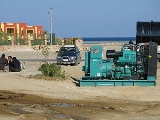
Diesel generator
Overview
Diesel engine
A diesel engine is an internal combustion engine that uses the heat of compression to initiate ignition to burn the fuel, which is injected into the combustion chamber...
with an electrical generator
Electrical generator
In electricity generation, an electric generator is a device that converts mechanical energy to electrical energy. A generator forces electric charge to flow through an external electrical circuit. It is analogous to a water pump, which causes water to flow...
(often called an alternator
Alternator
An alternator is an electromechanical device that converts mechanical energy to electrical energy in the form of alternating current.Most alternators use a rotating magnetic field but linear alternators are occasionally used...
) to generate electrical energy.
Diesel generating sets are used in places without connection to the power grid
Electric power transmission
Electric-power transmission is the bulk transfer of electrical energy, from generating power plants to Electrical substations located near demand centers...
, as emergency power-supply if the grid fails, as well as for more complex applications such as peak-lopping, Grid Support and export to the power grid.
Sizing of diesel generators is critical to avoid low-load or a shortage of power and is complicated by modern electronics, specifically non-linear loads.
The packaged combination of a diesel engine, a generator and various ancillary devices (such as base, canopy, sound attenuation, control systems, circuit breakers, jacket water heaters and starting system) is referred to as a "generating set" or a "genset" for short.
Set sizes range from 8 to 30 kW (also 8 to 30 kVA single phase) for homes, small shops & offices with the larger industrial generators from 8 kW (11 kVA) up to 2,000 kW (2500 kVA three phase) used for large office complexes, factories.
Unanswered Questions
Discussions

